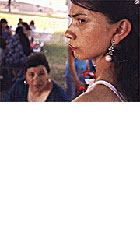
La Boda 2000
Distributed by Women Make Movies, 462 Broadway #500, New York, NY 10013; 212-925-0606
Produced by Jim McKay and Hannah Weyer
Directed by Hannah Weyer
VHS, color, 54 min.
Adult
Women's Studies, Multicultural Studies
Date Entered: 11/09/2018
Reviewed by Patricia B. McGee, Coordinator of Media Services, Volpe Library & Media Center, Tennessee Technological UniversityBy 4:30 a.m. in the migrant labor camp at Shafter, California, the Luis family is already up and preparing for the day’s work in the fields. Shrouded in long sleeves and bandanas, they harvest grapes in the 100-degree heat. The family, originally from Neuva Leon, Mexico, spends six months of the year working California’s fields and the remainder in their home in Mission, Texas in the Rio Grande Valley. At the age of 22, Elizabeth, the bride in this engaging documentary of a Latino wedding, has made the trip between California and Texas forty four times.
This exploration of Mexican-American migrant family life reveals the complexity and difficulties of daily life and close-knit nature of the family and the community. Although the Luis children are Americans by birth, the family has deep roots in Mexico; they celebrate holidays in Mexico, and Artemio Guerrero, Elizabeth’s fiancé, is a Mexican national. The wedding is a communal as well as familial event. Members of the community who have a special relationship with the family, Elizabeth’s padrinos, give cash contributions for wedding expenses. Everyone makes the effort to come to the celebration and help in the preparation for the wedding party, even though as Elizabeth says when they arrive at the Guerrero home in Neuva Leon they will “have to sleep like lizards.”
Elizabeth, soft spoken and articulate, and first of the children to graduate from high school, reveals both the conflicts between her “Mexican values and my American values,” and the discrimination faced by Mexican-Americans. As Elizabeth says, “We work for our family.” At times she came to school with blisters on her the knees from working in the fields, other times she missed school because of work. Some classmates looked down on her because of who she was and what she did. And the border patrol always closely questions her whenever she crosses back into the United States. Yet, the Luis family is determined to work for a good life. As San Juanita Luis, the family matriarch says,“we’re not perfect, but we’re trying not to go astray, trying always to do what we say.” While the migrant life is perhaps not what they will chose if circumstances offer alternatives, the young couple recognize that to live better off “we have to live on ‘the other side.’”
The sympathetic quality of the film is marred at times close-ups so intrusive as to caricature the faces of the family members. At other times the viewer wishes the camera would draw back and give more background to place the action in its visual context. However, for those unfamiliar with Latino culture, this documentary offers insight into the lives of a remarkable, and frequently undervalued, segment of our society.
Recommended for secondary programs and above and strongly recommended for Latino and multicultural studies.